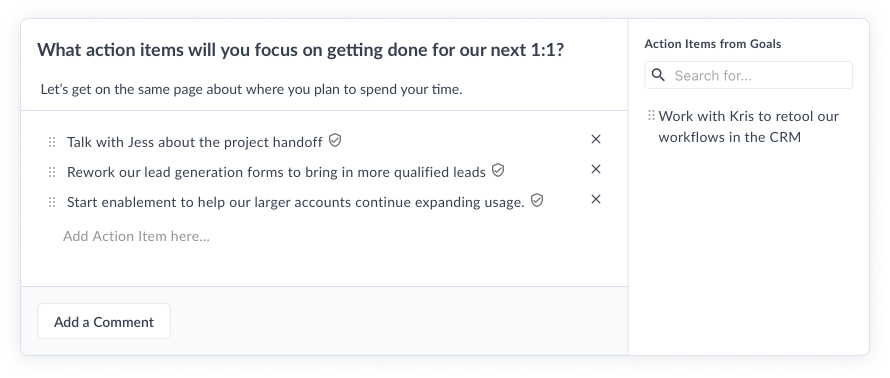Would you like to boost productivity, increase trust and have a healthier, happier team?
Download your FREE 1:1 guide now!
Have you ever found yourself wondering what the point of a one-on-one meeting is? You might have heard about how they’re supposedly the secret sauce to great management, but getting your reports to talk is like pulling teeth, and the experience usually just feels like a glorified status update.
If that sounds familiar, it’s most likely because you were never trained in the art of the great one-on-one. Heck, you might never have had a great one-on-one.
A 2018 West Monroe Partners study found that 59% of managers have never received any formal management training. Forty-two percent reported that they developed their management style by mimicking a previous manager. So, if you’ve never had a manager who modeled great one-on-ones for you, then you probably aren’t doing enough to distinguish them from all your other meetings.
The fact is, one-on-one meetings should be unlike any other part of your job as a manager. Why? Because they require you to share control of the meeting with your employee. Making one-on-ones into truly collaborative, rich dialogues requires a different set of skills than simply running a meeting. And to begin practicing those skills, you must first have a deep understanding of what one-on-ones are actually for.
Below, we’ll go over what to bring to one-on-ones, what to leave at the door, and how to make the changes that will take the anxiety out of these meetings, for both you and your team.
What One-on-Ones Are NOT For
As we said, you should use one-on-ones to have conversations you couldn’t have in any other context, but to do that, you need to bring not just a special kind of agenda but also a special kind of attitude.
Managers are used to taking charge of situations and zooming through their to-do lists, but bringing that type of energy to a one-on-one is like trying to play a gentle piano sonata AS FAST AS YOU CAN. While these meetings shouldn’t be totally unstructured, the primary thing you’re chasing is a feeling: you want employees to walk out feeling empowered, listened to, and confident about their next steps. Sure, you want to make sure you both have clarity on what’s being worked on and why, but that’s the easy stuff.

Routine Status Updates
Face time with the boss is a precious commodity for any employee, so don’t squander it by asking them to go over the minutiae of their day-to-day tasks. You can do that over email. A caveat here is that sometimes an employee will need to talk about the status of their current projects, and you should allow them to explore those issues. But do it in the context of removing roadblocks and answering questions.
Would you like to boost productivity, increase trust and have a healthier, happier team?
Download your FREE 1:1 guide now!
Meetings That Feel Like Tests
You want every member of your team to feel comfortable bringing their issues to you in one-on-ones, but that can’t happen if the meeting feels like a test they can pass or fail. If you ask them how they plan to proceed on a project, and they admit they’re not sure where to start, don’t chastise them; point out resources they can use.
By the same token, try not to pressure your employees to report that they’re always doing great and never have any problems. That pressure makes employees want to hide their issues from you, and if you don’t know about them, you can’t help them. You can alleviate this pressure by rewarding honesty in one-on-ones, proving that telling the truth will get your employee help, not punishment.
Big talk, no action
The most meaningful one-on-one conversation in the world won’t do you or your employee any good if you don’t translate it into action. If an employee tells you about a roadblock and you promise to help, but never follow up, they might not say anything the next time.
In order to hold yourself and your team member accountable for the goals you set in one-on-ones, you need to document what you both said. At Uptick, our one-on-one tool emphasizes the importance of documentation and follow-ups. Managers and team members can each make a note of topics they need to circle back to throughout the week or in the next meeting, and write a step-by-step plan for how to address their priorities.

What One-on-Ones Are For
One-on-one meetings should feel like a combination of a therapy session, improv performance, brainstorming meeting, and intimate coffee chat. What do all these interactions have in common? Collaboration and trust: two elements you can cultivate with enough care.
Helping Team Members Grow in Their Roles
One of the primary functions of one-on-ones is giving your team members personalized professional mentoring by working together to establish short- and long-term goals. Setting incremental benchmarks and helping your employees move forward in the company is how you keep them engaged and motivated.
To introduce that element into one-on-ones, ask your report to prepare for your next meeting by thinking about a new skill they’d like to learn or a new area of the business they’re interested in exploring. Then, work together to draw up a strategy to get them there. On their own, an employee may not have any idea how to make this happen, but as the manager, you can open the doors that can turn a dream into a plan.
Removing Roadblocks in the Way of Success
Any time you discuss a problem in a one-on-one—whether your employee brought it to you or it’s critical feedback you’re delivering—it should always be with the goal of offering support. That starts with showing curiosity, rather than blame, about the root of the problem.
For example, two employees could be turning in work late, but digging into the issue in a one-on-one can reveal that Employee A is being assigned too much work, while Employee B is struggling with time management. What looks like the same issue on the surface is actually two different things. Once you know that, you can remove the roadblocks by reassigning some of Employee A’s work and supervising Employee B more closely to ensure they stay on task.
Deepening Your Relationship
The personal element of one-on-one meetings is central to their purpose. Taking a moment to step back from the stress of work and connect on a human-to-human basis is how you form the kind of connection that inspires loyalty in your team. When you share a laugh and let your personality shine through, you’re giving your reports permission to bring their full selves to work.
One-on-ones should also be a safe place for employees to share personal problems with you. If your employee is going through a rough breakup, they probably don’t want to announce it to the entire team or send you an email about it. Every employee will have different boundaries regarding their personal lives, and some people won’t ever want to discuss them at. But regardless, one-on-ones should still be a safe environment to bring up these issues, so you can be aware of the impact they might have on their work.
Would you like to boost productivity, increase trust and have a healthier, happier team?
Download your FREE 1:1 guide now!
Asking Questions, Listening to the Answers
You need to come to one-on-ones ready to ask the kinds of questions that draw your employees out, and they can’t get away from with a one-word answer. So instead of “Do you know what to do on this project?” ask, “Tell me your next three steps on this project.”
Much like a good therapist, though, you also need to listen closely to the nuances of what your report says and stay attuned to variations in word choice and tone. Melanie Whelan, the former CEO of SoulCycle, attests to the value of close listening: “You have to ask a lot of questions and you have to really listen to the answers. Don’t be thinking about the next question, and don’t be thinking about what you’re having for lunch. Really listen, because in every answer there are at least three more questions you want to be asking.”
Hit the Reset Button on Your One-on-Ones
Understanding the goals of one-on-one meetings is one thing, but putting them into practice is another, and it requires some finesse. Employees are often wary of change, especially the kind that requires them to be more emotionally vulnerable in front of the boss. But if you lead the charge by changing your behavior and expectations, you can get your team to follow suit.
Ask Employees to Help Set the Agenda
You need to make it clear to every employee that from here on out, one-on-one meetings are their time. Encourage them to think of this time in terms of what they hope to get out of it: whether that’s working on professional goals, sharing problems, or clarifying expectations.
However, if you just show up to a one-on-one and tell an employee to run it themselves, you’ll likely be met with crickets. Instead, try a more structured approach to sharing the agenda. Tell an employee ahead of time to come with two issues they’d like to discuss and one goal they’d like to develop, and then they’ll have to participate. But they won’t be enthusiastic unless you can…
Be Consistent
You have to prove that you’re invested in these meetings by showing up on time, keeping track of issues from one meeting to the next, and actually offering the support you promise. Do that enough times, and employees will eventually see that being honest with you makes their job easier. But first, you have to…
Be patient
Relationship-building doesn’t happen overnight. One-on-ones require managers to exercise a special set of skills, and they require the same thing of employees. Your reports don’t often get the chance for face time with a supervisor, much less time that is centered around them, and they might not initially know how to take advantage of it. It’ll take time to earn their trust, but it’s time well spent.
Empower Yourself with the Right Tools
A lot of new managers are anxious about one-on-ones because measuring success or failure can feel so nebulous. So whenever possible, ground your work in concrete benchmarks you can use to hold yourself accountable and measure your progress.
Uptick is designed to help managers and employees keep track of one-on-one conversations, advance professional growth, and develop individualized agendas that evolve over time. When you see the needle start to move from one week to the next in your employee’s progress and your workplace relationships, you’ll know you’ve finally gotten the point of one-on-ones.
Would you like to build trust, increase productivity and boost team morale by having fresh, meaningful conversations with your team?
Try Uptick.


